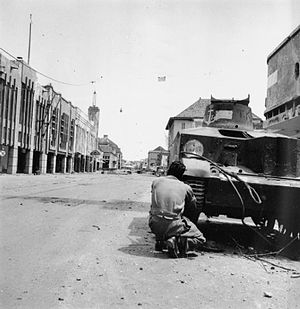Battle of Surabaya
| Battle of Surabaya | |||||||||
|---|---|---|---|---|---|---|---|---|---|
| Part of the Indonesian National Revolution | |||||||||
 A British Indian soldier uses a knocked out Indonesian nationalist tank as cover in a main street in Surabaya, November 1945. |
|||||||||
|
|||||||||
| Belligerents | |||||||||
| Commanders and leaders | |||||||||
| Strength | |||||||||
|
|
||||||||
| Casualties and losses | |||||||||
| 6,000 – 16,000 killed | 600 – 2,000 killed | ||||||||
The Battle of Surabaya was fought between pro-independence Indonesian soldiers and militia against British and British Indian troops as a part of the Indonesian National Revolution. The peak of the battle was in November 1945. The battle was the heaviest single battle of the revolution and became a national symbol of Indonesian resistance. Considered a heroic effort by Indonesians, the battle helped galvanise Indonesian and international support for Indonesian independence. 10 November is celebrated annually as Heroes' Day (Hari Pahlawan).
By the time the Allied forces arrived at the end of October 1945, the pemuda ("youth") foothold in Surabaya City was described as "a strong unified fortress". Fighting broke out on 30 October after the British commander, Brigadier A. W. S. Mallaby was killed in a skirmish. The British retaliated with a punitive sweep that began on 10 November, under the cover of air attacks. Although the European forces largely captured the city in three days, the poorly armed Republicans fought for three weeks, and thousands died as the population fled to the countryside.
Despite the military defeat suffered by the Republicans and a loss of manpower and weaponry that would severely hamper Republican forces for the rest of the revolution, the battle and defence mounted by the Indonesians galvanised the nation in support of independence and helped garner international attention. For the Dutch, it removed any doubt that the Republic was not simply a gang of collaborators without popular support. It also had the effect of convincing Britain that wisdom lay on the side of neutrality in the revolution; within a few years, in fact, Britain would support the Republican cause in the United Nations.
On 17 August 1945, Soekarno and Hatta declared the independence of Indonesia in Jakarta, two days after the Japanese emperor's surrender in the Pacific. As the news about the independence declaration spread throughout the archipelago, ordinary Indonesians felt a sense of freedom that led most to regard themselves as pro-Republican. In the following weeks, power vacuums existed, both from outside and within Indonesia, creating an atmosphere of uncertainty, but also one of opportunity. On 19 September 1945, a group of Dutch internees supported by the Japanese raised the Dutch flag outside the Hotel Yamato (formerly Hotel Oranje, now Hotel Majapahit) in Surabaya, East Java. This provoked nationalist Indonesian militia, who overran the Dutch and Japanese and tore off the blue part of the Dutch flag, changing it into the Indonesian flag. The leader of the Dutch group, Mr Ploegman, was killed because of mass anger.
...
Wikipedia
